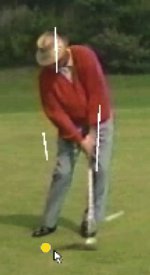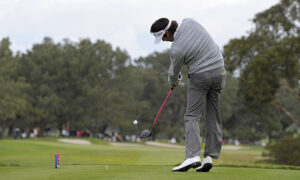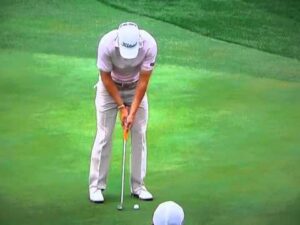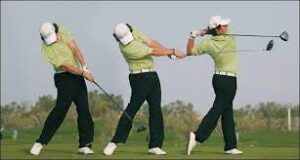Fat iron shots are one of the most frustrating shots in golf. They always occur when you tighten up for an easy but important shot. Your practice swing is perfect but when it really counts you chunk your club into the ground before the ball and the shot comes up well short of your planned location. Eliminate this problem and save many strokes each round you play.
You know how to swing an iron and you should also know that your iron shots need to reach the low point of the swing arc about 2-4 inches AFTER the ball. This causes under-spin and makes your ball elevate. You need to allow your hips to shift forward a few inches from your setup position during the swing. Why can’t you make this happen for every shot?
Problem:
When you want to make an important delicate shot, your mind and body tighten up. You limit your back swing and swing a little faster with your focus only being on your arms. You forget the rhythm of your body. Your arms move ahead of your body and chunk the ground behind the ball. Chunking the club into the ground about 3 to 6 inches before the ball means that your hands are bottoming out well before you reach your setup position. This proves that the early (or faster motion) of your arms and hands caused the problem.

Sam Snead swinging and grounding the club with the low point of his swing after the ball location (marked in yellow).
Solution:
Knowing that the late motion of your body or the fast motion of your arms caused the problem will help your mind solve this problem.
Make sure that your practice swing is exactly the same swing that you want when you move up to the ball. Ensure that you see that you are grounding the club or skim the grass about 2-4 inches in front of the imaginary ball location and finish your swing. If you miss the ground then take another practice swing. Duplicating the rhythm is key. Use the same rhythm to execute the shot with ground connection after the ball as you follow through.
Summary:
In previous weeks we have talked about cadence, rhythm and tempo. I can’t stress this enough. If you don’t think about controlling your tempo you will swing faster, with less backswing, less hip rotation and less shoulder turn. [Blogs that I receive show that this is Tiger’s current problem.] Slow your tempo down by saying words in your mind to keep a consistent rhythm. You may want to use the words: “Sweep-in-and Finish”. Use the words “Sweep-in-and” to slow down your backswing and transition. Say “Finish” in your down-swing and finish (in a balanced stance). Mental focus will improve your game.
Don’t waste strokes. Practice with GOLFSTR+ to learn your tempo. Straight arm backswing, wrist lag and release are so important to generate power WITHOUT FAT SHOTS. Buy one today at www.golfstr.com
* * * * * * * * * * * * * * * * * * * * * * * * * * * * * * * * * * *
BONUS OFFER: If you want to improve your tempo, transition and follow-through, GOLFSTR+ is a good starting point. We write these Weekly Swing Tips by viewing other blogs, getting tips from pros and getting ideas from GOLFSTR USERS. One of my great sources is ROTARY SWING GOLF.
I highly recommend this training service as they have almost 250,000 followers who love and receive their golf swing training videos. If you want to LOWER YOUR SCORES today: click below to check it out & subscribe.










